High above the familiar celestial landmarks of Ursa Major, Cepheus, Cassiopeia, and Cygnus, the constellation Camelopardalis perches almost unnoticed. Deriving its name from the Latin term for “giraffe,” Camelopardalis is a testament to the ancient practice of seeing and interpreting patterns in the stars. Camelopardalis is the 18th largest constellation in the night sky at 757 square degrees, contains 174 stars brighter than magnitude 6.5, and is thus easily visible to the naked eye under a dark sky. However, none top magnitude 4 in brightness, making Camelopardalis an easy constellation to miss and all but entirely washed out under city skies.
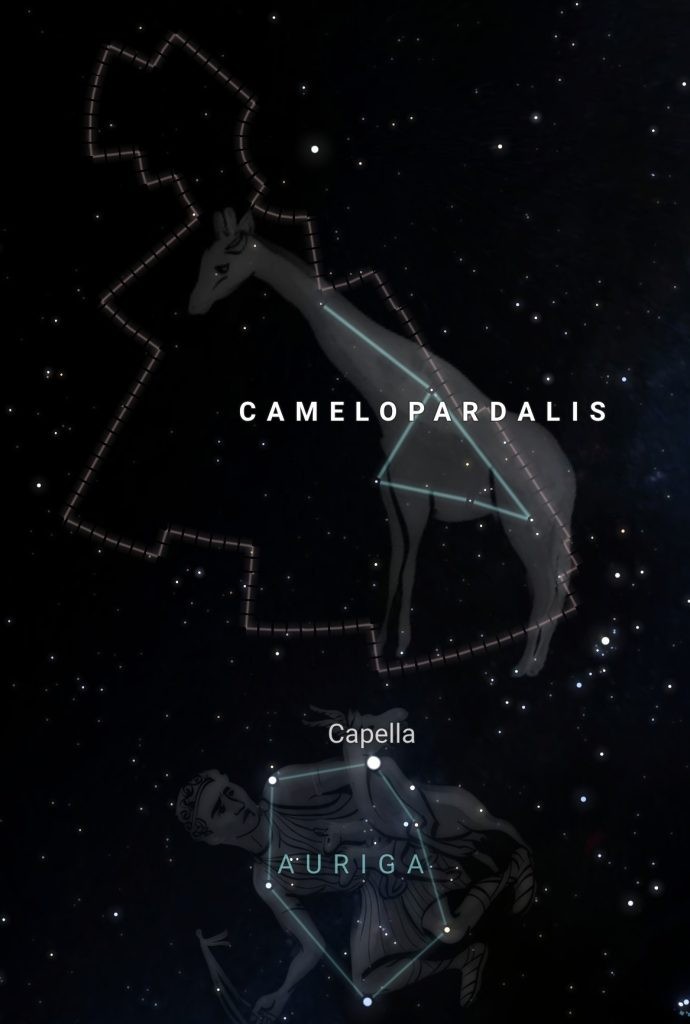
Contents in this article:
The Camelopardalis constellation is essentially a vast, empty area of the northern night sky, and its main feature is just how sparse it is of stars or deep-sky objects. This is also why it bears a rather unusual name; the constellation was only formally defined and named at all in the 1600s, well after the telescope was invented.
Camelopardalis borders the North Celestial Pole, where Polaris, the North Star, is located. As a result, much of the constellation lies permanently above the horizon for those at northern latitudes. It is essentially invisible from the Southern Hemisphere.
Origins of the Giraffe
While many constellations boast their roots in ancient Greek or Roman mythology, Camelopardalis is a more recent addition, tracing its origins back to the post-Renaissance era. It is an exemplary demonstration of how the boundaries of the known universe were expanding, not just in terms of spatial discovery but also in the cultural and imaginative breadth of the observers.
Johannes Hevelius, the 17th-century Polish astronomer and prolific celestial cartographer, is credited with introducing Camelopardalis to the world of stargazing. While charting out and detailing sections of the sky, Hevelius noted an uncharted and relatively dim area near the North Celestial Pole. Recognizing the potential for allocating the sector to a new constellation, he imaginatively likened its pattern to a giraffe, a creature that was, during his time, a rare and exotic novelty in Europe, having been introduced through oceanic trade and exploration.
The name “Camelopardalis” is an amalgamation of “camel” and “leopard”, terms that early European explorers and traders used to describe the giraffe, referencing its long neck, which is reminiscent of a camel, and its spotted pattern, which resembles that of a leopard. For Europeans of Hevelius’s era, the giraffe epitomized the mysterious allure of unexplored continents and unknown lands, much like the night sky was to the first generation of astronomers to have access to telescopes.
As with many constellations, the real significance of Camelopardalis lies not just in its stars but in its historical and cultural context. It represents a time of burgeoning exploration, both terrestrial and celestial. The constellation stands as a reminder of a period when the boundaries of the known world were rapidly expanding and when the skies themselves were not immune to the winds of change and discovery.
Where is the Camelopardalis Constellation in the Sky?
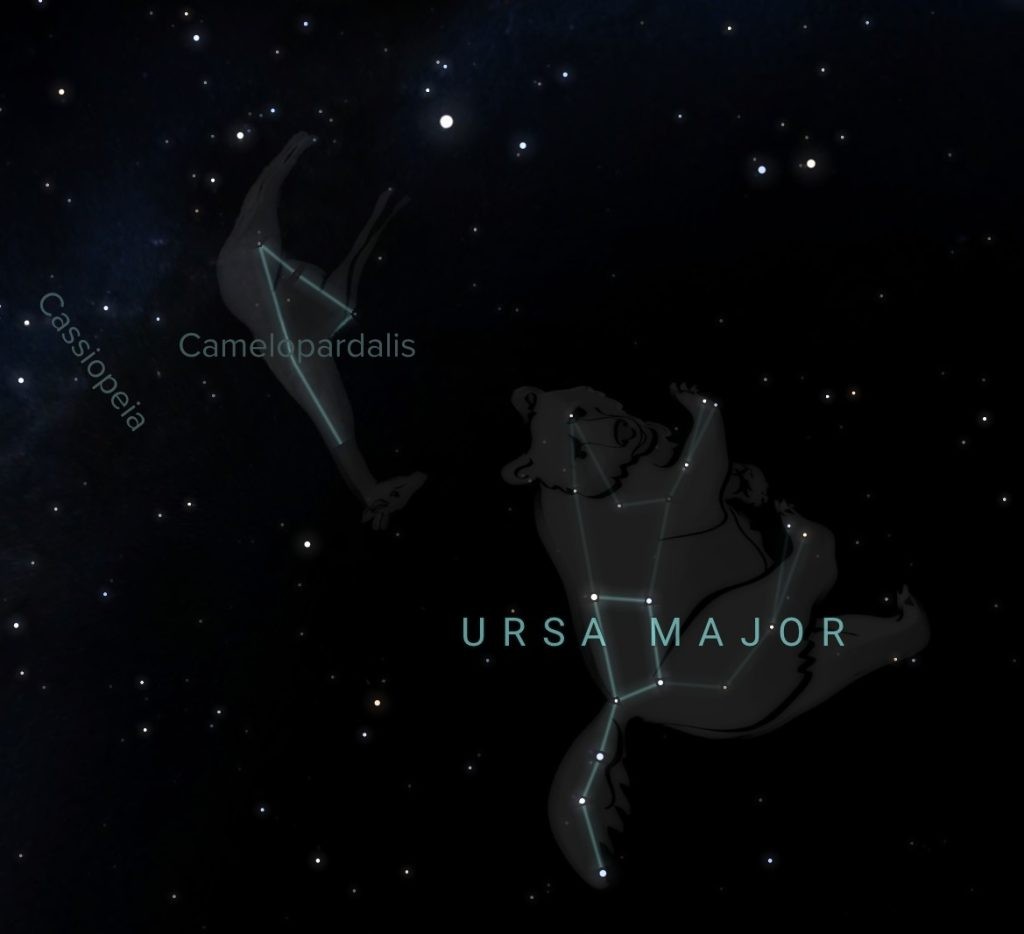
Camelopardalis constellation stretches out between some of the northern sky’s standout constellations. It is nestled between Ursa Major and Cassiopeia. By identifying these two easily recognizable constellations and focusing on the vast region between them, you’re in the right realm to spot Camelopardalis. While Camelopardalis doesn’t boast any particularly bright stars, its pattern is distinguishable by its sheer emptiness. The constellation’s stars are moderately faint, but their layout has a distinct elongated, patchy appearance that somewhat echoes the tall, lean stature of a giraffe.
It’s important to note that Camelopardalis hardly has a corresponding asterism befitting of its name, and the brightest stars in it are dimmer than apparent magnitude 4. Observers in city or suburban skies will see nothing but an empty patch of sky in the area where the constellation should be, and even under pristine conditions, Camelopardalis can be thought of as more of a neighborhood in the sky than a coherent pattern or arrangement of stars.
How to Locate Camelopardalis, The Giraffe
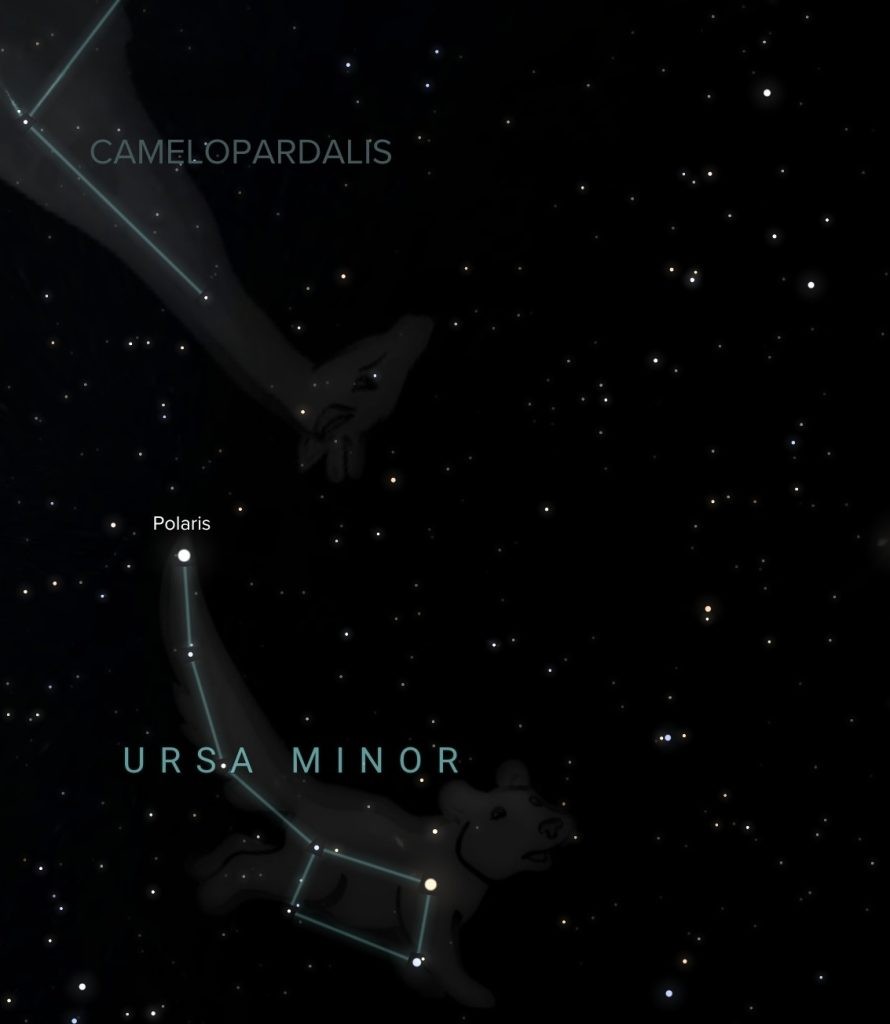
A pivotal pointer in the night sky, Polaris, the North Star, is an excellent starting point for finding the Camelopardalis constellation. Situated in the smaller constellation Ursa Minor, Polaris acts as a beacon. Once you’ve located Polaris, look to its east, and you’ll be gazing in the direction of Camelopardalis.
Camelopardalis is visible for much of the year in the Northern Hemisphere due to its proximity to the North Celestial Pole. However, the optimal times for observation are during the late fall to early spring, when the constellation rides higher in the night sky.
For those unfamiliar with Camelopardalis or the northern sky’s layout, a star map or stargazing app can be invaluable. These tools, especially the digital ones, often come with features that allow you to point your device at a section of the sky and identify constellations in real time.
Things to See in Camelopardalis Constellation
Important Stars, Double Stars, and Planets
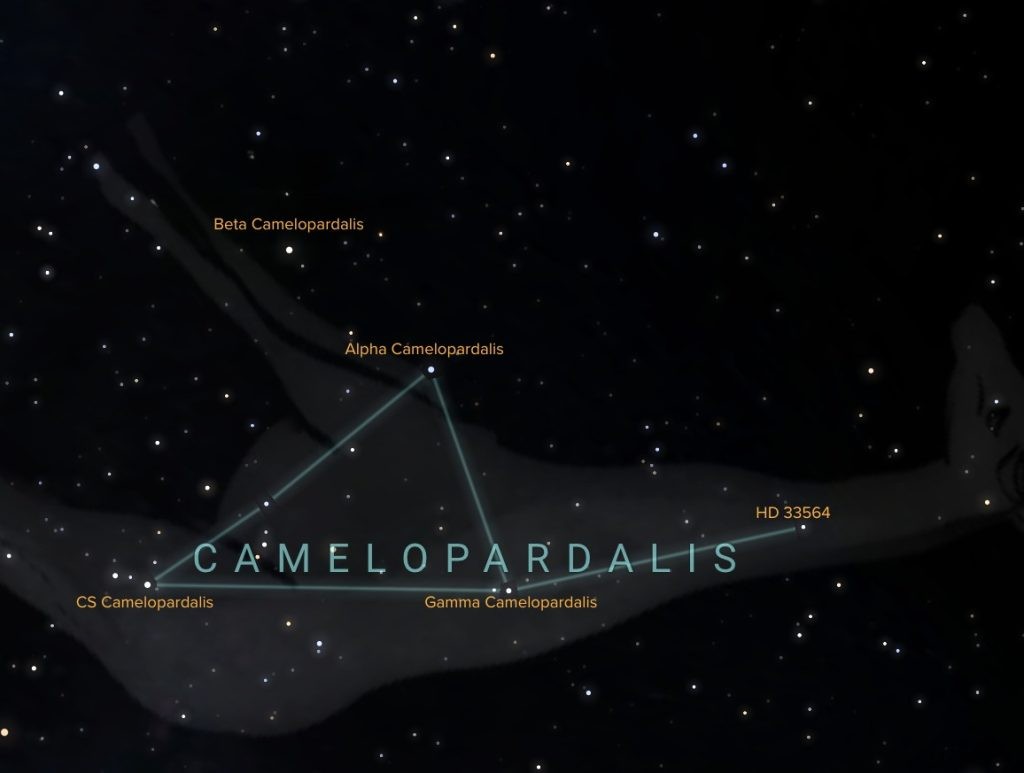
Taking the title of the brightest star in the constellation, 4th-magnitude Beta Camelopardalis is an orange supergiant star. While certainly big and luminous, being situated approximately 1,000 light-years from Earth, the star shines at just dimmer than magnitude 4. β Cam was born only 60 million years ago—more recently than the extinction of the dinosaurs on Earth—and spins unusually rapidly, possibly a result of it absorbing a planet or small companion star.
A variable and binary system, the blue giant CS Camelopardalis is the second brightest star in the constellation, with a peak brightness of magnitude 4.2. CS Cam’s companion is 2.5 arcseconds from the primary, far enough to split with a 4-6” or larger scope on a steady night.
Alpha (α) Camelopardalis is slightly fainter than Beta at magnitude 4.3. A blue supergiant 6,000 light-years away, it is among the most distant of the individual naked-eye stars that dot the heavens. Adjacent magnitude-4.7 Gamma Camelopardalis stands out as well. A binary system, it consists of a blue-white primary star accompanied by a dimmer companion about 1 arc minute away, easily split at 30x magnification or greater in a small telescope.
K Camelopardalis, or HD 33564, is a white main-sequence star a bit hotter and more massive than our own Sun, readily visible at magnitude 5. It hosts a single known exoplanet, HD 33564 b, a gas giant ten times the mass of Jupiter orbiting about the same distance from its star as Earth does from the Sun. The massive planet does lie within the habitable zone of the star (albeit barely) and could thus host a moon with life on it, like Pandora from the Avatar films.
Gliese 445 is a nearby red dwarf star in Camelopardalis and shines at magnitude 10.8, visible in most 50mm binoculars or a small telescope. It is currently 17.5 light-years away from us, but is rapidly approaching the Sun and will be 3.5 light-years away from us 50,000 years from now. Around the same time, the Voyager 1 space probe will pass about 1.6 light-years from the star. No planets around Gliese 445 are currently known to exist, however.
Star Clusters
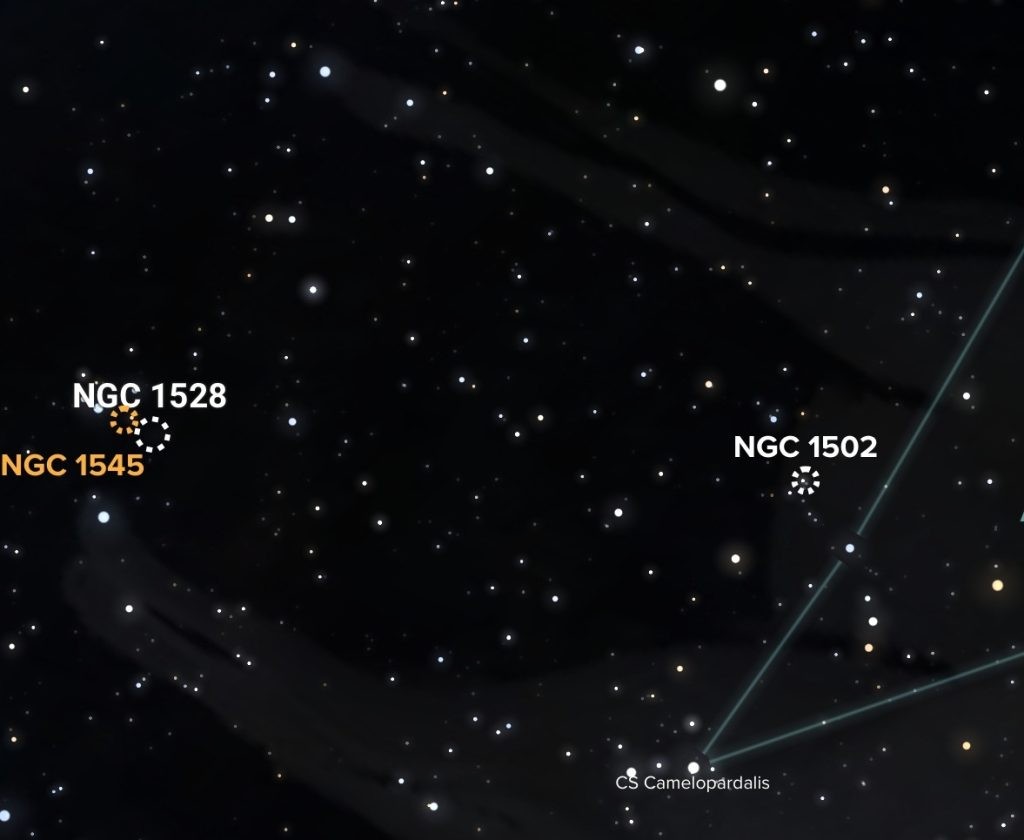
Unless you count extragalactic globulars (not visible with most amateur telescopes), there are no globular star clusters to be had in Camelopardalis constellation. Fortunately, a few open star clusters are visible with binoculars or small telescopes in this constellation.
One such cluster nestled within the boundaries of Camelopardalis is NGC 1502. A compact gathering of over 40 stars, this cluster presents a dazzling spectacle, especially when viewed through a moderate telescope. NGC 1502 is of particular interest to stargazers due to its proximity to Kemble’s Cascade, a striking asterism of stars that appear to cascade towards the cluster, creating a celestial scene reminiscent of diamonds spilling from a cosmic chalice.
Another cluster worthy of note is NGC 1528. This open star cluster is comparatively more spread out, with about 100 stars shimmering within a field that spans the apparent width of the moon. Lastly, NGC 1545 deserves mention. A more loosely bound cluster, its stars are dispersed over a broad area.
Nebulae
Due to the rather odd borders of this constellation, despite lying near the plane of the Milky Way, Camelopardalis constellation is home to few nebulae. However, two notable planetary nebulae exist within the bounds of this constellation and are interesting even with a modest telescope.
The Lemon Slice Nebula, formally known as IC 3568, is a bright and relatively small planetary nebula situated in Camelopardalis, the only one of its kind visible through amateur telescopes in the constellation. Its popular name arises from its strikingly round and symmetrical appearance, which makes it look somewhat like a slice of citrus fruit in photographs. Through a telescope, the nebula is greenish-blue in color and is unusually symmetrical, with a nearly perfect spherical shape, measuring just over 15 arc seconds – about the apparent diameter of Saturn – across. A 6” or larger telescope is ideal to resolve the finer details in the nebula and reveal its turquoise hue.
Located about 4,500 light-years away from Earth, the Lemon Slice Nebula is relatively young for a planetary nebula, estimated to be just a few thousand years old. Like many other planetary nebulae, it’s the result of a medium-sized star nearing the end of its life. As the star runs out of nuclear fuel, it expels its outer layers, creating a beautiful, glowing shell of ionized gas. The remaining core, which will eventually become a white dwarf, shines brightly, illuminating the ejected gas. The Wolf-Rayet central star inside the Lemon Slice is still shedding its outer layers and is thus fairly prominent at the eyepiece.
The other significant planetary nebula in this constellation is NGC 1501, also known as the Oyster Nebula. NGC 1501 is quite a bit bigger than the Lemon Slice at about 50 arc minutes across, or about the angular diameter of Jupiter at its closest approach to Earth. The Oyster lies a similar distance away, however, at around 4200 light-years away. Through a 6” or larger telescope, NGC 1501 appears as a small light blue to whitish disk with a fairly obvious central star; larger telescopes reveal the wispy, tendril-like structure of the nebula.
Galaxies
NGC 2403 is perhaps one of the most remarkable galaxies in Camelopardalis constellation. This intermediate spiral galaxy exhibits beautifully defined arms and an active star-forming region. Its similarities with the Triangulum Galaxy (M33) are often remarked upon by astronomers. Through telescopes, observers can detect the glow of its nucleus and the hazy light of its spiral arms, especially under dark skies. A 6” telescope reveals the galaxy, but detail usually requires a 10” or larger instrument.
NGC 2146, another entrant in the collection of Camelopardalis’ galaxies, is known for its dramatic appearance. This nearly edge-on galaxy is categorized as a barred spiral galaxy, but its most striking feature is its warped, twisted arms. Astronomers believe that a recent interaction or collision with another galaxy might have caused this distortion, offering a snapshot of the dynamic and often violent nature of the universe. NGC 2146 is visible in a 6” or larger instrument, with the galaxy’s prominent dust lanes showing up in 8-10” and greater apertures.
Another bright, if not exactly visually exciting, object is NGC 2655 (Arp 225), an intriguing lenticular galaxy. A 6” telescope has no trouble revealing NGC 2655, but its subtle, patchy dust lanes elude even fairly large instruments.
IC 342, often dubbed the “Hidden Galaxy,” is another spiral galaxy, nominally very bright, but it remains somewhat elusive due to its position behind the dense dust of our Milky Way galaxy. This is a similar, but more extreme version of the situation faced by the nearby Fireworks Galaxy in Cygnus. IC 342 is visible in 10” or larger telescopes under dark skies, but don’t expect to resolve any detail. IC 342 and other galaxies near it are members of the Maffei Group, one of the closest galaxy groups to us; however, much of the group is at least partly obscured by the dust of our own galaxy.
The Camelopardalid Meteor Shower
Meteor showers provide one of the most breathtaking spectacles in the night sky. These events occur when the Earth passes through the debris left behind by a comet, causing small particles to burn up upon entering our atmosphere, resulting in streaks of light popularly called “shooting stars”. In the constellation of Cameleopardis, observers are treated to one such meteor shower, with its origins tied to the comet 209P/LINEAR. The shower occurs in late May, peaking around May 24th with an estimated average of a few faint meteors per hour. This makes for a rather unexciting event, especially if you are under light-polluted skies, which might wash out most of the meteors.
Discovered in 2004, 209P/LINEAR has a rather interesting orbit that brings it into proximity to Earth every five years. The debris shed by the comet during its trips around the Sun leads to the meteor shower we observe.
Historically, the Camelopardalids are a relatively young meteor shower. Their debut appearance was in 2014, when predictions suggested that Earth would pass through dense trails of debris from 209P/LINEAR. This had astronomers and skywatchers buzzing with excitement, as there were expectations of a potential meteor storm—a scenario where one could see hundreds, if not thousands, of meteors per hour. While the inaugural show did not quite reach “storm” levels, it offered a splendid skyward display, cementing its place in the annals of meteoric events.
